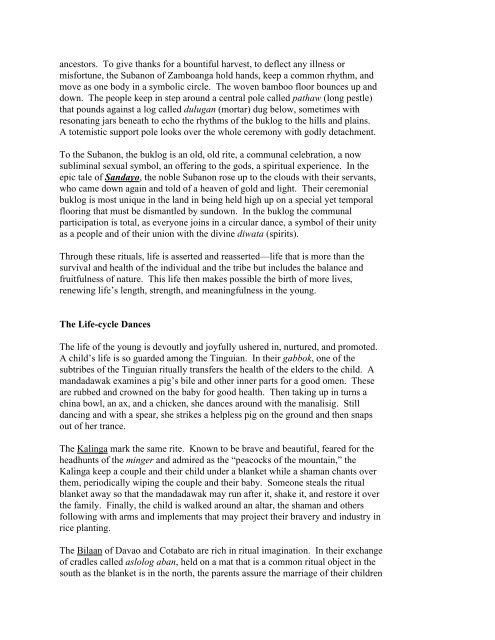THE ETHNIC TRADITION IN PHILIPPINE DANCE Ethnic dances are ...
THE ETHNIC TRADITION IN PHILIPPINE DANCE Ethnic dances are ...
THE ETHNIC TRADITION IN PHILIPPINE DANCE Ethnic dances are ...
Create successful ePaper yourself
Turn your PDF publications into a flip-book with our unique Google optimized e-Paper software.
ancestors. To give thanks for a bountiful harvest, to deflect any illness or<br />
misfortune, the Subanon of Zamboanga hold hands, keep a common rhythm, and<br />
move as one body in a symbolic circle. The woven bamboo floor bounces up and<br />
down. The people keep in step around a central pole called pathaw (long pestle)<br />
that pounds against a log called dulugan (mortar) dug below, sometimes with<br />
resonating jars beneath to echo the rhythms of the buklog to the hills and plains.<br />
A totemistic support pole looks over the whole ceremony with godly detachment.<br />
To the Subanon, the buklog is an old, old rite, a communal celebration, a now<br />
subliminal sexual symbol, an offering to the gods, a spiritual experience. In the<br />
epic tale of Sandayo, the noble Subanon rose up to the clouds with their servants,<br />
who came down again and told of a heaven of gold and light. Their ceremonial<br />
buklog is most unique in the land in being held high up on a special yet temporal<br />
flooring that must be dismantled by sundown. In the buklog the communal<br />
participation is total, as everyone joins in a circular dance, a symbol of their unity<br />
as a people and of their union with the divine diwata (spirits).<br />
Through these rituals, life is asserted and reasserted—life that is more than the<br />
survival and health of the individual and the tribe but includes the balance and<br />
fruitfulness of nature. This life then makes possible the birth of more lives,<br />
renewing life’s length, strength, and meaningfulness in the young.<br />
The Life-cycle Dances<br />
The life of the young is devoutly and joyfully ushered in, nurtured, and promoted.<br />
A child’s life is so guarded among the Tinguian. In their gabbok, one of the<br />
subtribes of the Tinguian ritually transfers the health of the elders to the child. A<br />
mandadawak examines a pig’s bile and other inner parts for a good omen. These<br />
<strong>are</strong> rubbed and crowned on the baby for good health. Then taking up in turns a<br />
china bowl, an ax, and a chicken, she <strong>dances</strong> around with the manalisig. Still<br />
dancing and with a spear, she strikes a helpless pig on the ground and then snaps<br />
out of her trance.<br />
The Kalinga mark the same rite. Known to be brave and beautiful, fe<strong>are</strong>d for the<br />
headhunts of the minger and admired as the “peacocks of the mountain,” the<br />
Kalinga keep a couple and their child under a blanket while a shaman chants over<br />
them, periodically wiping the couple and their baby. Someone steals the ritual<br />
blanket away so that the mandadawak may run after it, shake it, and restore it over<br />
the family. Finally, the child is walked around an altar, the shaman and others<br />
following with arms and implements that may project their bravery and industry in<br />
rice planting.<br />
The Bilaan of Davao and Cotabato <strong>are</strong> rich in ritual imagination. In their exchange<br />
of cradles called aslolog aban, held on a mat that is a common ritual object in the<br />
south as the blanket is in the north, the p<strong>are</strong>nts assure the marriage of their children
















